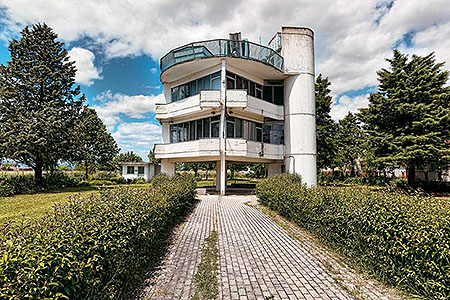The Municipal Observatory of Larissa is under the supervision of Vice Mayoralty of Culture and Science and belongs to the Department of Culture and Science of Division of Sports Culture and Social Policy of the Municipality of Larissa. It is located in the area of Giannouli, 5km northwest of the city of Larissa.

Presentation
The Municipal Observatory of Larissa participates in international astronomical research projects with a significant contribution related to the Sun, the occultation of the Moon and stellar photoelectric photometry. It is also contributing in the field of geophysics within a relevant program. Finally, the Municipal Observatory of Larissa has educational and training character for the wider region of Thessaly.

The Municipal Observatory of Larissa is visited daily by students of all educational levels. Also, every Thursday evening, the Municipal Observatory of Larissa has open doors hours for everyone. Guests are given a full tour, including the specially constructed projection room, where speeches about astronomical or seismological themes are held, as well as video views by related content. When weather conditions permit it, the guests can observe through a telescope the Moon, planets and stars.
Τime of entry to the public
Εvery Thursday evening at 20:00.
Programs
Astronomy programs of the Municipal Observatory of Larissa:
-
Photosphere
We take impressions of the photosphere phenomena daily on 20cm paper. After relevant elaboration and estimation, the observations are then sent to three international astronomical centers, the Solar Part of the American Association ofVariable Stars (AAVSO), the Observatoire Royal de Belgique and the British Astronomical Association in England and the Volssternwarte Paderborn in Germany. Also, we photograph the photosphere daily by digital camera Canon EOS 5D.
-
Chromosphere
The Observatory of Larissa participates in the important international research program High Energy Solar Spectroscopic Imager (HESSI). This program concerns the simultaneous observation from the satellite HESSI and earth observatories of specially selected active areas of the Sun's chromosphere where flares may be developed. The aim of the program is that the combined observations contribute to the understanding the solar flares generation mechanism and the natural causes which create them as well as the release of vast energy quantities throughout the whole electromagnetic spectrum. To photograph those active areas we use the monochromatic filter Lyot, at the line Ha of the hydrogen (6563 A ), capable of carrying the light from the center of the line Ha, from ± 0.1 A up to 1.0 A , towards the red and blue part of the spectrum and thus, it is possible to study the activity of the gasses. Also, with the special digital camera PRO LINE PL 11002M-2 by Finger Lakes Instrumentation, attached to the filter Ha and portable computer, we receive the photographs with rate one per minute.
-
Sudden Ionospheric Disturbance (SID)
The program SID concerns the indirect electronic monitoring of the solar flares. Its basic principle is as follows: There is a continuous monitoring of the signal (carrier) which is transmitted by an earthy station at VLF (very low frequencies) using the ionosphere as a means of relay. During a solar flare, the intense electromagnetic radiation released causes ionospoheric disturbances resulting to the monitoring of an intense disturbance with amplification or debilitation of the signal (which is monitored by the electronic receiver of the Observatory). After the relevant calculations and valuations of the data at the end of each month, the monthly bulletin of the Observatory of Larissa " ObsLar Bulletin " which includes the corresponding flares characteristics (Start, Max, End, Importance) is sent to the A.A.V.S.O. in the USA, the Observatoire Royal de Belgique, the British Astronomical Association and the Volssternwarte Paderborn in Germany. The international code of the Observatory of Larissa for this program is Α107.
Lunar Occultation
An important international astronomical program which concerns the timing determination of occulted and divulged stars from the lunar disk. The accomplished lunar occultation observations are sent to the International Occultation Timing Association (IOTA), which has the international supervision of the program.
The Observatory of Larissa has been participating for years at the international AAVSO Photoelectric Photometry (PEP) observing program whose purpose is to study a group of 80 specially selected macro-periodic variable stars with small wavewidth. We make experimental observations with photoelectric and ocular methods in order to determine the minimum periods of the special category of variable of Algol type (eclipsing binary stars). We also participate in the concurrent program of photoelectric photometric observation of the star IM PEG. The purpose of the earthy and satellite observations is to accomplish a sophisticated examination of certain aspects of the theory of relativity.
a) We monitor the seismic activity of the wider area of Thessaly with seismograph of the Observatory. The recorded earthquakes, after their calculation and archiving in special publications, are then sent to the Geophysical Laboratory of the Aristotle University of Thessalonica and the Geodynamic Institute of Athens.
b) Also, we have installed nine accelerographers within the urban web of Larissa, with a prospect of thickening the ant seismic network. The purpose of this network is the determination of the maximum terrestrial acceleration of Larissa.
The Observatory of Larissa is visited by students of all levels all year round. In the specially adapted and equipped with modern projection instruments room at the second floor, we provide lectures and projections of films or videos of astronomic interest. Also, on all Thursday afternoons admission to the Observatory is free for all members of the public.






